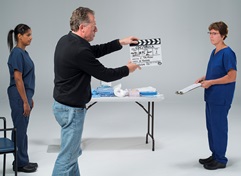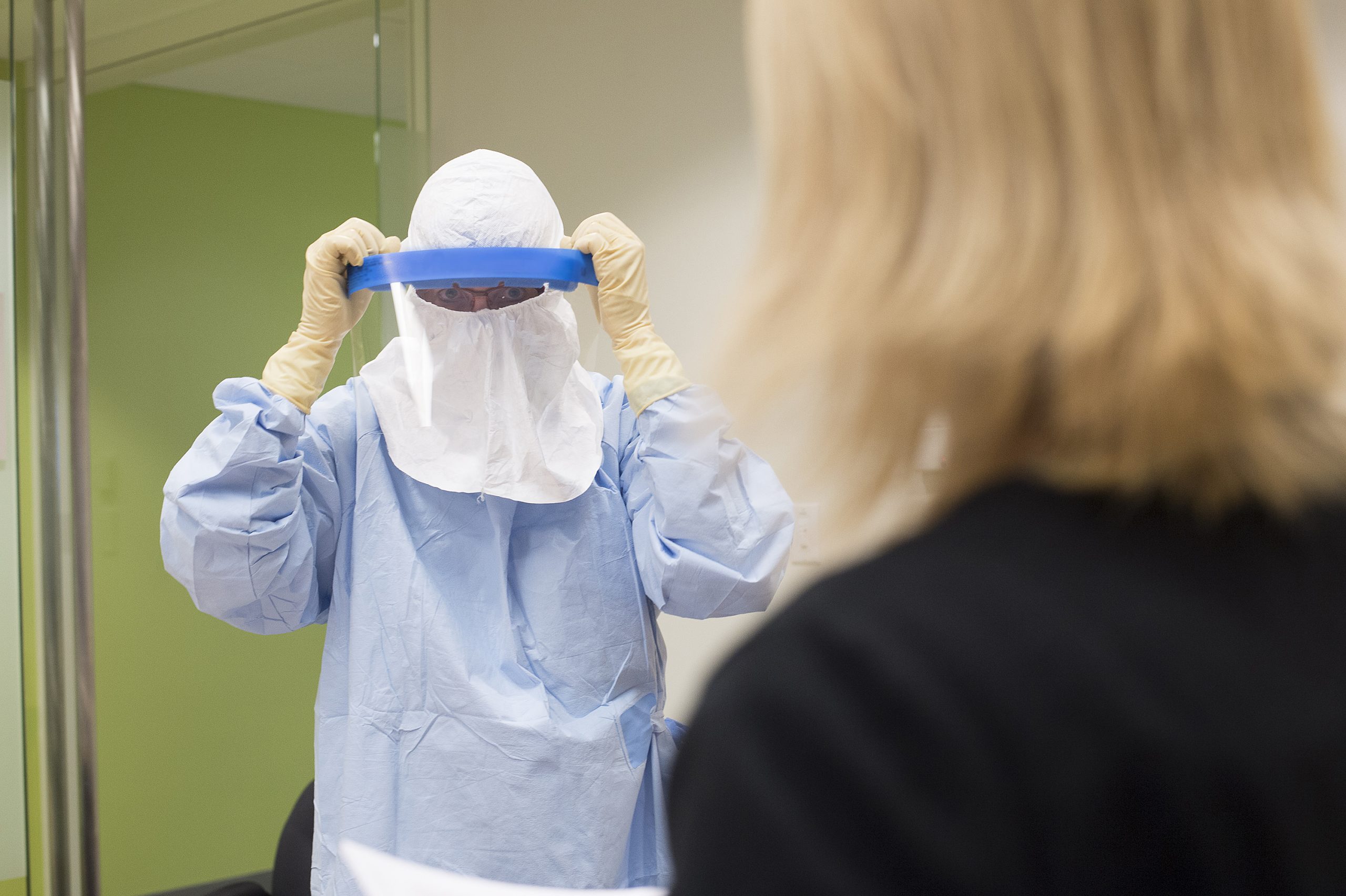Your body is covered from head to toe in protective equipment, and it’s 115 degrees Fahrenheit inside your outfit. Your hands sweat under two pairs of gloves. An ill-fitting hood creeps down your forehead and nearly covers your eyes, but you cannot touch your head to shift it back up. To top it off, the exterior of your protective garb is partially covered with bodily fluids from a patient with Ebola.
The time comes to leave the patient’s room without leaving a trace of the virus on you or carrying it outside the room. You are anxious and tired but careful to follow infection-control protocols as you remove a disposable face shield, hood, mask, booties and other garb. Yet as you do, a piece of hair falls down over your eyes. In a split second and without thinking, you brush it back, and an infected glove glances across a misty eye. The virus is in you.
In a health care world where infection control methods are part of daily practice, Ebola requires a new level of vigilance. Even scrupulous health care providers could get infected without the proper training and support on how to put on and take off personal protective equipment, or PPE.
The new Ebola protection guidelines for PPE use issued this month by the U.S. Centers for Disease Control and Prevention are a critical step in protecting patients, health care professionals and populations in the United States and abroad. Highlights of these new guidelines include leaving no skin exposed and requiring a trained observer to actively help the health care provider to follow the protocols for donning and removing their protective equipment. Because there is very little that one can do to prevent infection after exposure to this unforgiving virus, it is essential that clinicians know this guidance inside and out, become competent in putting on and removing PPE and have a “buddy” to coach them to ensure that they adhere to each and every step.
But like many clinical guidelines, following them is like following the directions for assembling an IKEA chair. They need to be translated into something that providers can easily absorb, that points out the most important steps and provides guidance for implementing them in real time, under real-world constraints. We need to create systems that help health care workers to follow these guidelines, and clinicians need to practice until they are competent. Health care workers also need to know how to respond in those instances when something doesn’t go according to plan.
With that in mind, the CDC asked the Johns Hopkins’ Armstrong Institute for Patient Safety and Quality to convene a team to produce a series of interactive, online training programs on following the new PPE guidelines. Released this afternoon, the videos provide guidance for putting on and removing PPE and allow users to select training specific to the type of respirator and body covering that they will be wearing. Another video module, which guides trained observers on how to be effective in their roles, will be available in days. The free course will also be available on iTunes U.
These modules are the result of intense but productive collaborations by more than 40 individuals with expertise in infection prevention, patient safety, nursing, teamwork training and human factors, as well as in instructional design and videography. Joining diverse experts across Johns Hopkins University, they converged on Baltimore from groups such as the Association for Professionals in Infection Control and Epidemiology, the Society for Healthcare Epidemiology of America and academic institutions such as Miami University (Ohio).
This training program was enriched by this transdisciplinary approach. These experts translated CDC policy into bedside practice that can be carried out in the real world. Human factors specialists, for instance, observed hospital staff during Ebola preparedness training, to identify the various ways that things might go wrong while wearing or removing PPE. Could a provider’s eyeglasses fall off while they’re delivering patient care? What if the provider is wearing a powered-air purifying respirator and it fails in the middle of patient care? What if providers don’t get sufficient time to put on their equipment? The team’s analysis is either addressed in the videos or was provided as feedback to the CDC.
Other experts have incorporated methods from teamwork training to guide the trained observers in how to be active, effective advocates for safety. This includes such strategies as using closed-loop communication to ensure that the provider understands critical instructions from the observer, establishing “red-flag” words for breaches in protocol and reminding tired providers when they are approaching high-risk steps. We know that it should take about 30 minutes to properly remove PPE for Ebola, and these observers have to coach providers to take their time.
 Instructional designers and videographers have translated this guidance into easily digestible modules that will help adult learners adopt new behaviors and develop new habits.
Instructional designers and videographers have translated this guidance into easily digestible modules that will help adult learners adopt new behaviors and develop new habits.
If you watched 60 Minutes on Sunday night, you heard clinicians at Texas Presbyterian Hospital Dallas describe the intense fear they initially felt when they understood that they would be treating Thomas Eric Duncan, the first person to die of Ebola in a U.S. hospital. One described tearing up at the prospect of caring for him. But they also put those fears aside and embraced their mission. They talked about the intense conditions of treating a patient with Ebola — the massive amounts of diarrhea and vomiting. One health care provider said that when he removed his PPE, it looked like he had been in a swimming pool. Still, you could see the deep pride and compassion they brought to Duncan’s care as the only people who could comfort him as he spent his final days in a hospital room without family.
Certainly, this empathetic, self-sacrificing spirit is what we see in West Africa’s Ebola outbreak, where local and international health care workers are delivering care in austere conditions. But several thousand more health care workers are needed in West Africa and may be hard to recruit. Concerns about how they will be treated when returning to their countries only compound that challenge. Yet we know that even basic treatments, such as rehydration therapy and electrolyte replacement, can drastically improve the odds of survival. It’s vital that we give clinicians — and the public at large — confidence that we can help patients survive the most contagious stage of Ebola infection and keep it from spreading to ourselves and others. Hopefully, these modules will help meet this critical need.
Useful links
- New Ebola Preparedness PPE modules
- CDC Ebola website
- APIC Ebola Infection Prevention and Control Resources
- SHEA Ebola Infection Control Resources
- Johns Hopkins Medicine Ebola website
- Johns Hopkins School of Public Health Ebola Forum (October 14, 2014)
- Video: CDC and Johns Hopkins Develop Ebola Training Modules for Health Care Workers

Thank you for the videos! They fabulous for our training needs. A standardized checklist for the modules to match the equipment would be very helpful. We could modify as needed. Please consider adding.
My job as Head of Quality and Risk Department in a private hospital in Indonesia requires me to educate 1300 staff including doctors, nurses, cleaning services, tray passers, and others on the preparedness for Ebola Virus Disease. I never realize that using PPE is so stressful for health care workers. Thank you for your inspiring thoughts.
Pingback: New Ebola Training Modules Will Help Safeguard Patients, Providers, and the Public | Doctella